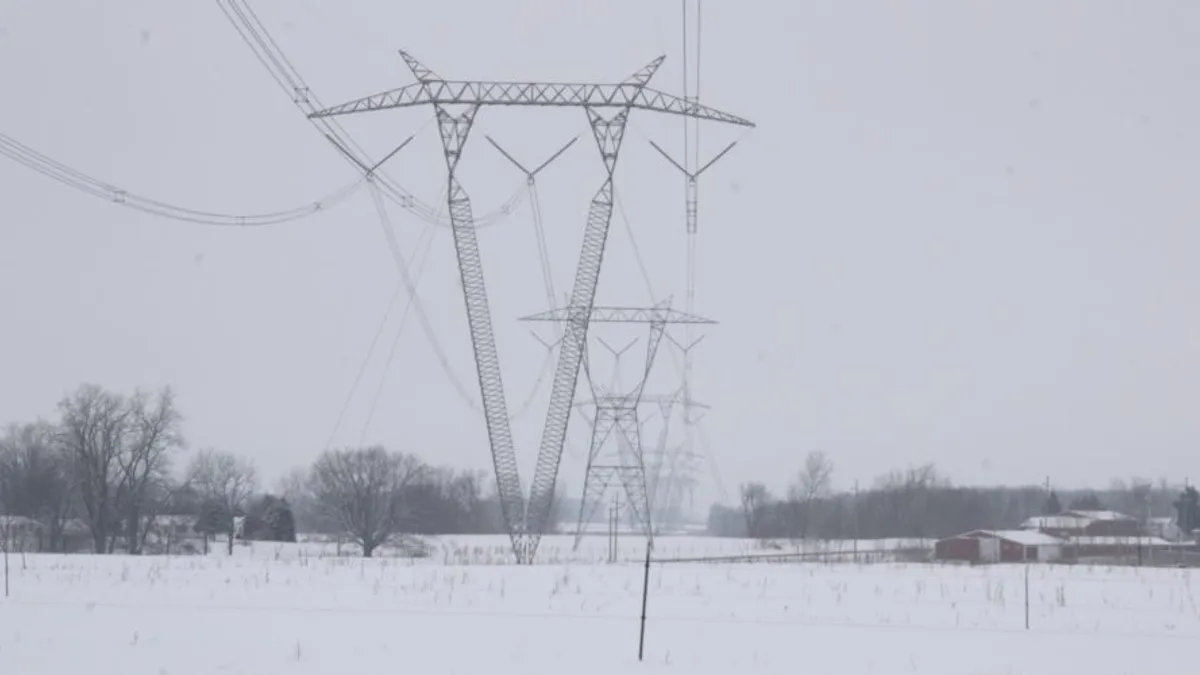For the past two years, proceedings at the Public Utilities Commission of Ohio (PUCO) have been nearly consumed by a single issue — subsidies for aging power plants.
On Oct. 12, regulators approved a distribution modernization rider for FirstEnergy, giving the utility the ability to recover an additional $204 million annually from ratepayers for the next three years in order to make grid investments. The decision came after FERC blocked earlier plans to provide direct income supports to aging coal and nuclear plants owned by FirstEnergy and AEP Ohio through special power purchase agreements.
In his concurrence (p.184), PUCO Chair Asim Haque noted that the move was “undoubtedly unconventional” for a state with a deregulated electricity market. Typically, regulatory approvals of utility cost recovery is tied to “expenditures made in constructing/maintaining service.” But with the “distribution modernization rider,” PUCO hopes to provide financial assistance so FirstEnergy “will be healthy enough to make … modernization investments when called upon.”
Financial difficulties for both FirstEnergy and AEP stem from the PJM electricity market, where many aging baseload plants cannot compete with low-cost natural gas and renewables.
While opponents argue those baseload plants should simply retire, PUCO regulators approved supports for them in March to ensure fuel diversity and grid reliability. When FERC blocked that route, FirstEnergy turned to the rider, while AEP decided to sell some of its plants and push for full re-regulation of the Ohio utility market.
In the PUCO decision, Haque notes these organized market issues are “not unique” to FirstEnergy or the state of Ohio. In fact, a growing number of states are considering some sort of “around market mechanism” to preserve at-risk generating capacity and ensure the financial health of their utilities.
“One state is an anecdote; five or six states is a trend,” said Ray Gifford, former chair of the Colorado Public Utilities Commission and author of a recent white paper on around market reforms.
“What struck us is it's not just Democratic or Republican states,” he said. “It’s red Ohio and deep blue New York and Massachusetts.”
The widespread retirement of baseload generation presents a number of challenges, from the loss of carbon-free nuclear plants to potential generation shortfalls. And while motivations vary, Gifford says the spread of state efforts to stem the tide of retirements shows that many policymakers are increasingly dissatisfied with the design of organized markets across the nation.
Without concerted action to alter market constructs, Gifford is concerned some states will turn back to a vertically-integrated utility model — putting the entire organized market experiment at risk.
“When you have plausible and it seems to me serious talk in Ohio about reintegration, that puts these markets in crisis,” he told Utility Dive. “It seems to me markets are generally in much more crisis than anybody thinks right now.”
The organized market dilemma
In their white paper, Gifford and colleague Matthew Larson note that “few, if any, restructured regions of the country have proven immune to the problem” of generation retirements.
In PJM, MISO, ERCOT, NYISO and ISO-NE, aging coal and nuclear plants have been unable to recover their fixed costs and are increasingly going offline as a result. The retirements have been occurring at such a “disquieting frequency” that a full inventory is infeasible, the authors write, but recent figures back up the trend.
All told, more than 50 GW of coal generation are scheduled to retire between 2012 and 2020, according to SNL, while nuclear plants in Illinois, New York, California, Massachusetts and elsewhere are the subject of high-profile discussions over potential retirement and replacement capacity.
A number of factors contribute to the trend, including low gas prices and an influx of cheap renewable energy that can sometimes push power prices into negative territory, Gifford and Larson wrote. But the former Colorado PUC chair believes there’s a deeper issue at play as well.
“The problem with these markets — and maybe it's not a problem, but a feature — is they clear at the marginal cost of production,” he said. “Well, at the marginal cost of production, you’re not covering your fixed costs.”
In theory, capacity market payments should help generators cover those fixed costs and keep capacity online. But low demand growth and cheap gas have kept capacity prices down in markets like PJM and ISO-NE, and some regions like ERCOT lack capacity markets altogether.
In those cases, recovering fixed costs becomes a question of “counting on scarcity rents to emerge” during periods of high electricity demand, Gifford said.
“If you look at what New York is doing explicitly … [and] what Ohio was doing implicitly, it's back-dooring capacity payments to the utilities,” he said. “So it's trying to solve the same problem in perhaps a slightly politically inelegant way, but this industry is always going to be pretty intimately regulated because of its capital requirements.”
State fixes
Across different states, the retirement of baseload capacity presents a number of issues. When coal and nuclear capacity goes offline, natural gas is likely to replace much of it, stoking fears in some regions of an overreliance on the fuel, particularly during winter months when gas supplies are more likely to be interrupted.
Where nuclear generation is on the chopping block, environmental goals come into play as well. If retiring nuclear plants are replaced with fossil generation, state carbon goals under the Clean Power Plan could be put in jeopardy, as well as broader U.S. climate goals.
In the face of those issues, Gifford and Larson write that state fixes can be split broadly into three groups:
-
The maintenance fee or “backdoor capacity payment,” which provides financial support to utilities through income guarantees for aging plants or other subsidies;
-
The prescriptive replacement capacity approach, which mandates which type of generation must replace retiring plants, and;
-
Complete vertical reintegration or re-regulation of a state utility sector.
Thus far, the maintenance fee approach has proved most common, though states have attempted different versions. The first high-profile case was in Maryland, which sought to guarantee income for a natural gas plant by requiring distribution utilities to enter into 20-year contracts for its power.
Federal energy regulators balked, challenging the rule on the grounds that it infringed on the Federal Energy Regulatory Commission’s authority to regulate interstate power markets. Last year, the Supreme Court agreed, throwing out the program in Hughes v. Talen Energy Marketing, a decision that also invalidated a similar program in New Jersey.
But tension between state and federal energy jurisdiction did not end there. After Ohio regulators approved income supports for FirstEnergy and AEP, FERC stepped in again, blocking the special PPAs and rescinding the affiliate sales waivers for both utilities. That pushed FirstEnergy to file the proposal approved Oct. 12, in which regulators devised a distribution rider that would not fall under FERC’s jurisdiction.
Whether the Ohio rider and a number of other around market programs will pass legal and regulatory muster remains to be seen. In New York, state regulators unanimously passed a Zero Emission Standard that would direct billions to three upstate nuclear plants to keep them online. Though the program was designed to avoid a legal challenge along the lines of Hughes, it faces lawsuits from generators and consumer groups in the state.
A similar program proposed in Illinois did not pass in the last legislative session, prompting Exelon to announce it would close two nuclear plants there if it cannot achieve the bill's passage next year.
Those states seek to alter the market outcome of plant retirements, but others have sought to mandate the capacity mix that will replace them. In Massachusetts, state lawmakers passed a law mandating increasing clean energy procurements, including 16 GW of offshore wind and 12 GW of hydro and other renewables. And in California, Pacific Gas & Electric has asked regulators to approve its plan to replace the Diablo Canyon nuclear plant with a mix of renewables, storage and energy efficiency.
In each instance, around market actions have been met with stiff resistance at the state level and often from federal regulators as well, but policymakers have pushed on. The fact that states like Ohio and New York have persisted illustrates “that states remain focused on addressing the issue of how to retain baseload power in organized markets despite the U.S. Supreme Court and FERC rebukes of around market solutions generally,” Gifford and Larson wrote.
Re-regulation in the offing?
Along with income supports and mandated replacements, some utilities are pushing their states to reconsider organized market participation altogether and re-regulate their states into the traditional vertically-integrated utility model.
Ohio, again, is the bellwether: AEP has promised to cease investments in its generation fleet, spin off what assets it can, and push for legislation to re-regulate the state’s utility system. But it’s not alone. Utilities in Michigan are supporting legislation to end an energy choice program available to 10% of state customers. A spokesperson for Consumers Energy recently called deregulation a “failed experiment.”
None of these proposals are as far along as the New York nuclear subsidies, for instance, but AEP is expected to put forth legislation to transfer its generation assets from its competitive business to regulated utility AEP Ohio.
“I think the reintegration question is, who's going to go first?” Larson said. “[Ohio] went first on the around market piece, so it kind of makes sense that they would be at that question first.”
Both he and Gifford fear a domino effect — that if one state re-regulates, others will follow, potentially unraveling entire organized market constructs. In the face of such widespread dissatisfaction with the markets, Gifford said the onus is on FERC and other federal policymakers to devise comprehensive fixes.
“If they want to preserve their market structure, they need to start coming up with answers for what states perceive as real policy deficiencies in these markets,” Gifford said. “I don’t mean to cast dispersions on FERC, and I'm not sure what they'd do, but their market experiment is in jeopardy, and the states, which still have a lot of power, some of them look poised to reject it.”
But if the need for a solution is clear, the details of one are less so. While Exelon and AEP have called for a price on carbon as the most straightforward way to preserve nuclear plants, the current cap-and-trade system in the Northeast is not delivering carbon prices sufficient to save nuclear plants — and prospects of a legislative fix are slim.
“The outcomes you’re getting in the marketplace are so dramatic,” Larson said, “that even if the nuclear capacity is valued in some way through that [carbon] market, it's not enough due to all these other things going on.”
Similarly, baseload generation could be kept online with more robust capacity auctions, an idea championed by ISO-NE CEO Gordon van Welie. But Gifford doubts the level of support needed would ever be palatable for state policymakers.
“It doesn’t seem to me politically acceptable to have a capacity auction that’s going to raise enough money explicitly to keep those units [online],” he said, “and nobody is talking about a capacity auction of the length that would meet the nuclear needs.”
At its core, Gifford said the problems with organized markets today can all be traced back to the fact that we “can’t resist the temptation to screw with the price system.” More than in other industries, policymakers and the public have a vested interest in the outcomes of organized electricity markets — whether related to power reliability, climate change or other externalities.
“We want markets, but we want to preordain the outcomes of these markets, and that's not what a market is about,” Gifford said. “My libertarian soul that has always wanted to believe that markets are always the answer to everything has come to realize for basic social political reasons we're not going to let the utility sphere do that, because we don’t really want it."
If some solution cannot be found to assuage the state concerns with organized markets, Gifford and Larson think their futures may be in doubt. The big battles to watch will be the coming debates on New York’s nuclear subsidies and the Ohio deregulation debate.
“If [the New York program] survives, everybody can say, 'I’ll come up with my own around market solution to come up with any resource portfolio I think I need,'” Larson said. “But if that goes down, I don't know what all is left. I'm sure someone else will come up with a new twist on it, but at some point you end up at reintegration.”





















